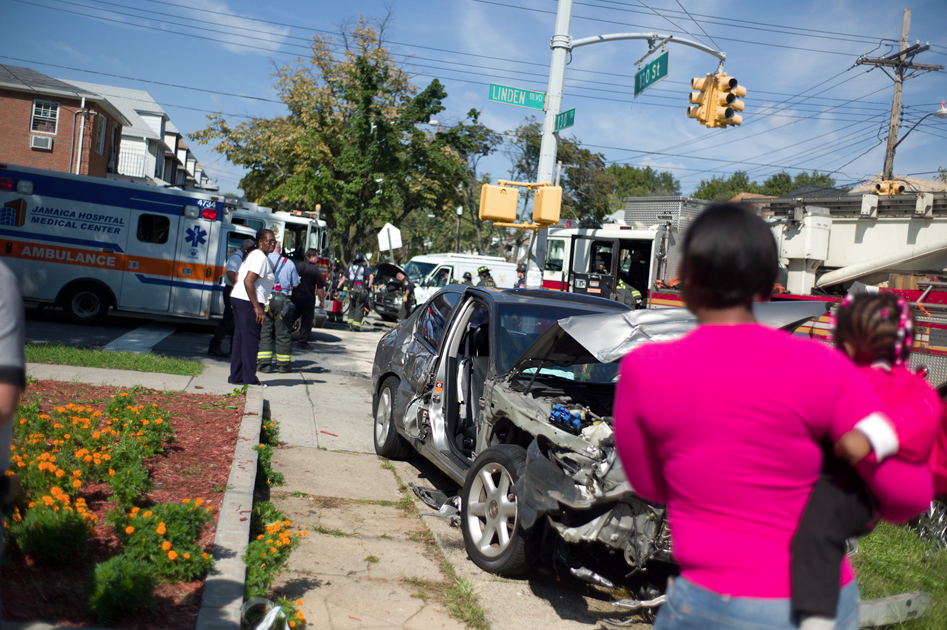Car accidents, like the one above, are pretty common events in the US, somewhere in the vicinity of 12 million per year. And that’s probably one reason why we don’t see very many photographs of them in national and regional newspapers. That the above photograph of an accident in Queens showed up in the WSJ’s “ New York Photos of the Week” slideshow for October 2-8 is thus a bit odd.
For one thing, it’s not a particularly good photograph. The caption reports a head-on collision but we can only see one vehicle; the car we can see is obscured by the person standing in front of it; and the cropping is somewhat off kilter yielding an unbalanced image with too much empty space on one side, and too much clutter on the other. But more than that, there is nothing that seems to distinguish the event itself. No one died, though there were injuries, and it doesn’t seem to have been the result of road rage, alcoholism, or texting while driving … all topics that seem to be of some recurring interest—at least in local newspapers. It appears simply to have been a run of the mill car crash. One of the 12 million. And what makes its placement all the more curious is that there are two other photographs of relatively ordinary car accidents in the same slideshow for a total of three out of eighteen images. One can only assume it was a very slow news week in the Big Apple.
Or maybe something else is going on here. Maybe the point is precisely the ordinariness of such accidents in contemporary society. Amidst the work and play of everyday life accidents simply happen. Individuals may be responsible in some measure, but in an advanced technological society calculated risks are also systemic, animated by the conditions of modern life. And yet, as the photographs in the WSJ imply, there is also a certain randomness to all of it. Here two cars hit one another head-on, there two police cars run into one another, or a van runs into a store front. All we can do is clean up the mess and move on. Its how we live our lives.
Of course, what counts as ordinary is relative to time and place. And so we have another photograph concerning an automobile “accident” that circulated across the blogosphere and showed up on more than a few photographic slide shows in the past week:
The place is East Jerusalem. The driver of the car is the leader of an Israeli settlement. The boy hurtling through the air is a Palestinian youth who, along with the other boys in the photograph, was allegedly throwing stones at the car. Depending on who you want to believe the driver was either trying to run the youths over or attempting to escape their attack. There is plenty of evidence to support each interpretation, but truth to tell, the photograph really does very little to help us sort it all out. What the photograph does indicate, however, is the ordinariness of everyday life within the settlements of the West Bank, a world where settler violence is so common that it becomes impossible to distinguish an accident from a violent assault. Or, perhaps more to the point, it suggests the sense in which the ordinary risks of everyday life in some parts of the world life far exceed the otherwise simple concerns of random mishaps and misfortunes.
Photo Credit: Ken Maldonado/Wall Street Journal; Ilia Yefimovich/Agence France-Presse/Getty


your analysis of the photo from east jerusalem is astonishingly shoddy. not only do you present the material as “it cd go either way” when the overwhelming evidence suggests a scene set up for photographers so that they can flood our screens with their dishonest “visual rhetoric,” but your conclusion, which only mentions “settler violence” as if the poor Palestinians were innocent victims of a constant aggression, suggests that you yourself are the victim of the very visual rhetoric you claim to analyze. i suggest you look more systematically at the evidence involved and offer your readers more than a drive-by shooting. You might start with Lenny Ben David’s analysis: http://lennybendavid.com/2010/10/mohammed-dura-redux-another-attempt-at.html.